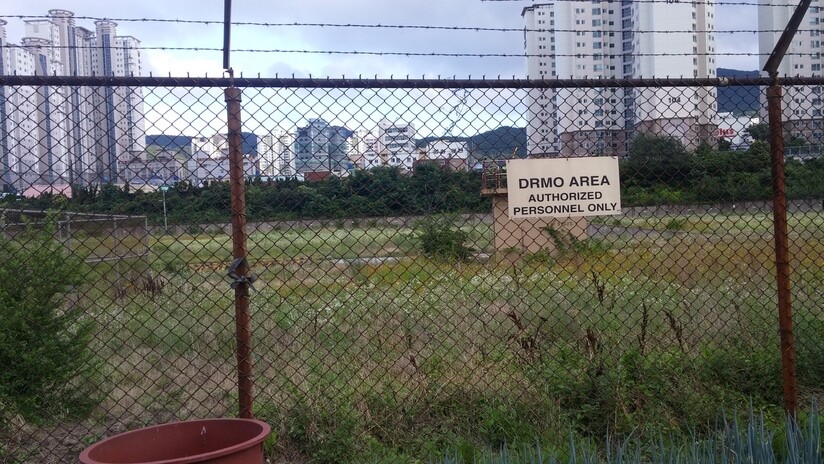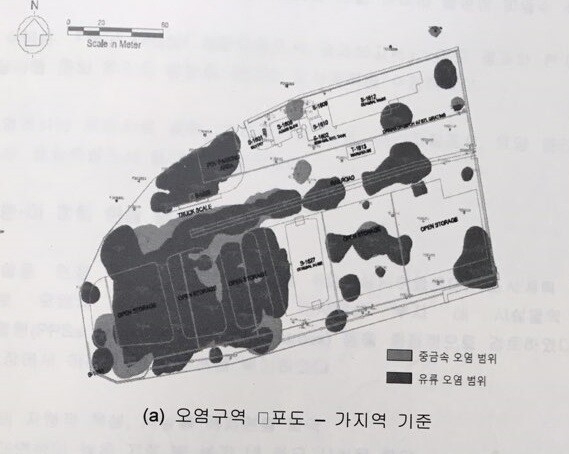hankyoreh
Links to other country sites 다른 나라 사이트 링크
11 years after US decamped, military base in Busan still festering with pollution

Between Gaegeum Station and Dong-eui University Station on line two of the Busan subway system is the polluted site of a former American military base. The site occupies 29,354 square meters of the Donggam neighborhood of Busan’s Jin District, with a KTX car repair center on the east and a residential area, including a complex of high-rise apartments, to the west. Eleven years after closing, the base remains polluted with oil and heavy metals. Even though the pollutants are seeping out of the base, the US decamped without dealing with the pollution. The site was not returned to the South Korean government until 2015, and since then government ministries have been dodging responsibility for the cleanup.
When the site was being used as a US military facility, it was called the Busan DRMO, meaning Defense Reutilization and Marking Office. While it’s only one ninety-fifth of the size of the Yongsan Garrison in Seoul, it’s badly polluted, and a cleanup is estimated to cost 6.8 billion won (US$6.05 million). Fed up with the pollutants leaking from the Danggam neighborhood, Busan city government asked the Office for Government Policy Coordination in Oct. 2016 to designate who is responsible for the cleanup, but even this request has been disregarded for a year now, the Hankyoreh confirmed.
“In Oct. 2016, we asked the Ministry of Defense, the Ministry of Land, Infrastructure and Transport, and the Office for Government Policy Coordination (under the Prime Minister’s Office) to issue an executive order designating who is responsible for cleaning up the polluted land and groundwater at the Busan DRMO, but we have yet to receive any response,” a Busan city official said during a recent telephone conversation with the Hankyoreh. In 2013, the city of Busan and Busan Jin District confirmed that the land outside the base contained a high concentration of total petroleum hydrocarbons (TPH) and zinc. So on Oct. 5, 2016, they sent an official request to the head of the Office for Government Policy Coordination, the Minister of Land, Infrastructure and Transport, and the Minister of Defense to quickly take measures to deal with the land pollution at the Busan DRMO, but almost one year later, they’re still waiting for an answer.

As of July, the Hankyoreh has confirmed, the Ministry of Land, Infrastructure and Transport (MOLIT) insists that the Ministry of National Defense is legally responsible for cleaning up the returned base, while the Ministry of National Defense holds that the cleanup should be handled by MOLIT, which owns and uses the land. The Office for Government Policy Coordination said that no decision has been reached because of the sharp disagreement between the ministries, while the Ministry of Environment maintains that environmental issues at US military bases that have been returned to South Korea are not in its jurisdiction. And so three years have passed since the base’s return without anyone giving Busan an answer.
After being ceded to the US military in 1973, the site housed a depot for recyclable goods and a waste incineration plant. The base was closed in Aug. 2006, as part of South Korea and the US‘s Land Partnership Plan (LPP), which is relocating American military bases to Pyeongtaek, Gyeonggi Province and Daegu. An environmental pollution survey carried out by South Korea and the US before the base was closed found that oil components (including carcinogens such as benzene, toluene and xylene) and heavy metals such as arsenic, cadmium and lead exceeded standard levels in half the total area.
While the US troops had all left and severe pollution had been confirmed in 2006, it was not until Mar. 2015, that the slow negotiations ended and the base site was returned to the South Korean government. The conclusion of environmental deliberations between the two countries was that the US forces would leave the base without cleaning up despite the severe pollution. A hazard assessment report that was drafted in 2011 according to the Joint Environmental Assessment Procedure (JEAP) agreed upon by the US and the administration of Lee Myung-bak in 2009 concluded that there was only 41 square meters of polluted land at the Busan DRMO and that hardly any cleanup work was necessary.
Compared to the 2006 survey, the 2011 survey was shorter and used fewer soil collection sites and samples. Even so, it confirmed that 21 oil-based substances and heavy metals exceeded standard levels. But the hazard assessment report only assesses “real and immediate hazards to the human body” when soil or groundwater is directly consumed, touched or inhaled, and it concluded that the site was generally not hazardous. The conclusion of the report was that the US military was exempted from responsibility for the cleanup. Since the JEAP agreement in 2009, which set the criteria for South Korea-US environmental negotiations when returning US military bases, including the Busan DRMO, the US military has never cleaned up a polluted base that it has returned after this kind of hazard assessment.
In the future, the Busan DRMO is supposed to be used as the Busan train car garage for the South-Busan KTX line, under the Korea Rail Network Authority. In an internal report at the beginning of this year, the authority reportedly concluded that it will cost 6.8 billion won just to clean up the DRMO site and that the cleanup will take three years. “Inter-ministry deliberations are made more difficult by the high cost of the cleanup. Before long, we’ll be arranging another round of deliberations,” said an official with the Office for Government Policy Coordination.
By Lim Ji-sun, staff reporter
Please direct questions or comments to [english@hani.co.kr]

Editorial・opinion
![[Column] Season 2 of special prosecutor probe may be coming to Korea soon [Column] Season 2 of special prosecutor probe may be coming to Korea soon](https://flexible.img.hani.co.kr/flexible/normal/500/300/imgdb/original/2024/0426/3317141030699447.jpg) [Column] Season 2 of special prosecutor probe may be coming to Korea soon
[Column] Season 2 of special prosecutor probe may be coming to Korea soon![[Column] Park Geun-hye déjà vu in Yoon Suk-yeol [Column] Park Geun-hye déjà vu in Yoon Suk-yeol](https://flexible.img.hani.co.kr/flexible/normal/500/300/imgdb/original/2024/0424/651713945113788.jpg) [Column] Park Geun-hye déjà vu in Yoon Suk-yeol
[Column] Park Geun-hye déjà vu in Yoon Suk-yeol- [Editorial] New weight of N. Korea’s nuclear threats makes dialogue all the more urgent
- [Guest essay] The real reason Korea’s new right wants to dub Rhee a founding father
- [Column] ‘Choson’: Is it time we start referring to N. Korea in its own terms?
- [Editorial] Japan’s rewriting of history with Korea has gone too far
- [Column] The president’s questionable capacity for dialogue
- [Column] Are chaebol firms just pizza pies for families to divvy up as they please?
- [Column] Has Korea, too, crossed the Rubicon on China?
- [Correspondent’s column] In Japan’s alliance with US, echoes of its past alliances with UK
Most viewed articles
- 1[Column] Season 2 of special prosecutor probe may be coming to Korea soon
- 2‘We must say no’: Seoul defense chief on Korean, USFK involvement in hypothetical Taiwan crisis
- 3No good, very bad game for Korea puts it out of Olympics for first time since 1988
- 4Division commander ordered troops to enter raging flood waters before Marine died, survivor says
- 5Is Japan about to snatch control of Line messenger from Korea’s Naver?
- 6Korea’s 1.3% growth in Q1 signals ‘textbook’ return to growth, says government
- 7Is N. Korea threatening to test nukes in response to possible new US-led sanctions body?
- 8[Editorial] Korea’s surprise Q1 growth requires objective assessment, not blind fanfare
- 9[Editorial] New weight of N. Korea’s nuclear threats makes dialogue all the more urgent
- 10‘Weddingflation’ breaks the bank for Korean couples-to-be